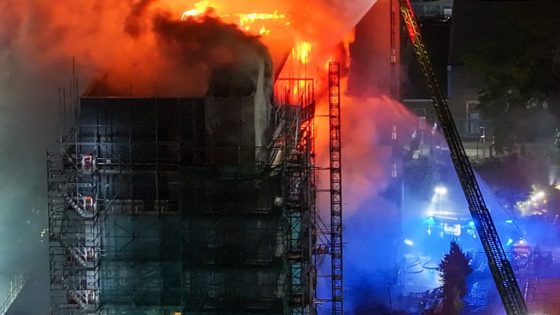A Dagenham building badly damaged by fire during cladding remediation works is set to be demolished, Construction News can reveal.
More than 80 people were made homeless when fire ripped through the Spectrum Building, a seven-storey mixed-use building in Dagenham, in August. The building was in the process of having “non-compliant” cladding removed at the time.
A few days later, the London Fire Brigade (LFB) and Health and Safety Executive (HSE) announced they would work together to investigate the source of the fire.
However, the building owners have now decided to demolish the building. The Spectrum Building is owned by Arinium Ltd and managed by Block Management UK.
Liberal Democrat Baroness Brinton said in the House of Lords on Monday (25 November) that the building owner had not discussed its plans with residents and leaseholders, adding that the council “cannot force the owner to the table”.
Barking & Dagenham Council told CN the building owners opted for demolition following several surveyor reports that “confirmed that the building is unsafe”.
The council added it had worked closely with residents to help them secure longer-term accommodation, including in the borough’s affordable homes. Barking & Dagenham said it was still working to rehouse three households, although the majority have moved into new homes.
A spokesperson said: “While this is a private block not owned by the council, we have continued to provide humanitarian support to residents affected by the devastating fire.”
The council has also offered emergency accommodation, rest centre access, essential supplies, advice and wellbeing and trauma support for affected residents, the spokesperson added.
Residents told a parliamentary committee more than two years before the fire that their block did not comply with building regulations when built, speaking of the stress on leaseholders living in “unsafe, unsellable flats with increasing service charges”.
Several fire experts told Construction News in the days following the emergency that the non-compliant cladding had by that point been removed, and that the scaffolding in place for the remediation work may have contributed to the rapid spread of the blaze.
They also spoke of the heavy damage the building sustained. Fire-safety expert Arnold Tarling, who warned about the risks of combustible cladding in the years leading up to Grenfell, said the timber-framed roof structures had burnt down.
Fire engineer Frances Peacock, who carried out an independent investigation into the source of the fire, told CN the building was “extensively damaged” and the top two floors “completely destroyed”.
“It was a poor-quality conversion and I don’t think it can now be salvaged,” she said.
She added: “Like Grenfell, Spectrum was a 1970s building of sound construction with good fire resistance. Yet both buildings became fire hazards after they both had work done to them in the 21st century; ironically both around the same time.”
The ongoing HSE probe will investigate how cladding works were organised, and whether the main accountable person had a duty to prevent fire spread.
An HSE spokesperson said: “The criminal investigation covers both our role as the Building Safety Regulator and matters that fall under the Health and Safety at Work etc. Act 1974 and the Building Safety Act 2022. We will continue to work closely with LFB throughout this process.”
Block Management UK has been contacted for comment. CN also attempted to call Arinium Holdings at the address listed in its accounts.

